 |
 |
 |
 |
 |
 |
 |
 |
 |
 |
 |
 |
 |
 |
 |
 |
 |
 |
 |
 |
 |
 |
 |
 |
 |
 |
 |
 |
 |
 |
 |
 |
 |
 |
 |
 |
 |
 |
 |
 |
 |
 |
 |
 |
 |
 |
 |
 |
 |
 |
 |
 |
 |
 |
 |
 |
 |
|
The Pneumatic Crystal Lattice Principle |
|
|
|
PXL, pronounced pixel, is an acronym for Pneumatic Crystal Lattice. The name refers to the construction technique and to the individual components used in such. PXL construction is a potentially patentable system, although it is being released to the Public Domain, which can be used in building "octet trusses" as developed and patented by R.B. Fuller, in 1961 [pat. # 2,986,241]. |
|
|
| The following is a description of the octet truss, taken from Fuller's patent application. |
|
|
NATURE'S SIMPLEST STRUCTURAL SYSTEM
In the Universe is the tetrahedron.,The regular tetrahedron does not fill all-space by itself..The octahedron and tetrahedron complement one another to fill all-space..Together they produce the simplest, most powerful structural system in Universe. |
|
|
|
I first used the name octahedron-tetrahedron truss..I then shortened it to the "octet truss"..Having shipped it across state lines, I applied for a trademark for the octet truss. |
|
|
|
It is interesting that at the present time, twenty-two years later, the U.S. government is specifying in it's bids for space structures the octet truss (my copyrighted trademark name) for all the main structuring for space stations. |
|
|
|
SYNERGETIC BUILDING CONSTRUCTION
My invention relates to a truss construction for building purposes; particularly to roof, wall and floor framework and to a combined roof and wall framework or wall and floor framework, etc. |
|
|
SUMMARY
In my prior patent, no. 2,682,235, issued June 29, 1954, I have disclosed how to gain a surprisingly favorable weight-strength ratio in structures of generally spherical form, now widely known both here and abroad as "geodesic domes"..The present invention is a discovery of how to gain an extremely favorable weight-strength ratio in structures of other forms, including those which are functionally conformed in shape for special purpose applications as well as more conventional forms based on the rectangular prism rather than the sphere. |
|
|
| In the sphere, the tremendous gain in the "ratio" accrued primarily from a unique arrangement of the main structural elements in which they are all aligned with great circles of a common sphere..In this sense, geodesic construction could be considered inapplicable as such to building frameworks of other than spherical form. However, I have found that if a flat roof, wall or floor framework is built up of struts (or sheets) of equal length (size) in such a fashion that such elements are comprised within a common octahedron-tetrahedron system, the strength of the framework is far greater than would be predictable using any conventional formulae based on resolution of forces and known values of strength of materials..In fact, my practical tests have shown that the actual strength of these "flat" one system octahedron-tetrahedron structures so far exceeds calculated values as to suggest a hypothesis that such structures are "synergetic" in the sense that we have a stress behavior in the system which is unpredicted by it's parts. |
|
|
| In general, my invention consists of a roof, wall and/or floor framework consisting of a truss in which the main structural elements (e.g. struts or triangular sheet members) form equilateral triangles interconnected in a pattern consisting of octahedrons and tetrahedrons with the major axes of all octahedrons in parallelism throughout the framework..Thus all such structural elements are comprised within a single octahedron-tetrahedron system and this apparently yields a new optimum of tensile-compressive integrity throughout the framework. |
|
|
| PXL construction provides an improved weight-strength ratio over regular octet construction, because it is not dependent on the compressive strength of the materials used in their construction. Whereas Fuller's octahedrons and tetrahedrons are built from materials, which exhibit both tensile and compressive strengths and therefore have mass, PXLs derive their compressive strength by being inflated and can be as thin as a membrane. |
|
|
| PXL construction takes us one step closer to nature's efficient building system by imitating the structure of biological tissue. A unified matrix of soft cells can form a rigid collective framework, by slightly increasing the pressure within each of the cells..The combined strength in the collective structure is greater than the sum of all the individual cells. The combination of pressurized cells creates a geometric interplay of compressive and tensile forces, which define a solid wall, requiring only a minimum wall to contain the pressure. This principle of forces applies at any scale and with any material. |
|
|
|
Compression (large arrows) and tension (small arrows) balanced in PXL faces |
|
|
|
 |
|
|
|
PXLs are pre-manufactured inflatable polyhedrons, made from any of a variety of materials..The standard PXLs are octahedrons, tetrahedrons, and inflated triangles, but they can also be made to fit custom geometry, where needed. Each of the edges of the PXL incorporates an external flange with regularly spaced grommets, for attaching to other PXLs. Each PXL is fitted with a valve stem for inflation or filling. |
|
|
|
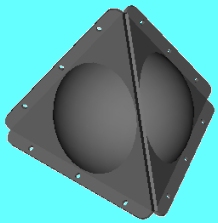 |
|
|
|
This first illustration is of a tetrahedron PXL. The tetrahedron has four equilateral triangle faces..The actual faces are made from flat material, but are shown with a slight spherical bulge, to give the impression of how they look when inflated. Notice the edge flanges, with grommet holes..They are shown here with three holes, but the actual number depends on the size of the PXL..All PXLs of the same size would have a matching hole pattern. |
|
|
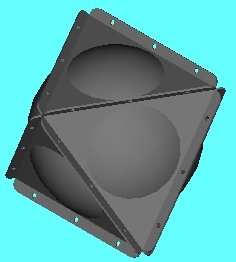 |
|
|
The next illustration is of the octahedron PXL. The octahedron has eight equilateral triangle faces, which are the same size and have the same flanges and hole pattern as those on the tetrahedron..In typical construction, tetrahedrons are mated with octahedrons, but you could also mate octahedrons with other octahedrons, where needed. |
|
|
|
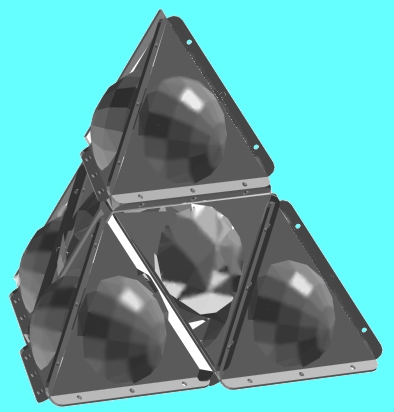 |
|
|
This illustration shows an octahedron with tetrahedrons attached to four of its faces. Notice how, when combined, the five PXLs form a larger tetrahedron. This assembly, alone, may be used as a sub-assembly in a larger structure, but there are other sub-assemblies that are more useful in building.
PXLs can be assembled into solid shapes, walls, floors and ceilings, but they can also be assembled to form beams and columns, which can be enclosed within a tent made of fabric or an assembly of smaller scale PXLs. |
|
|
|
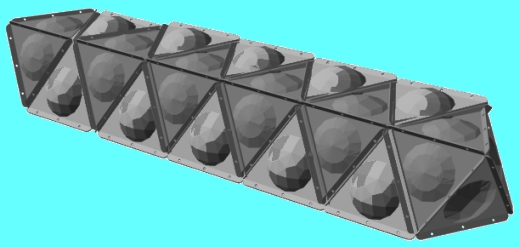 |
|
|
|
A PXL BEAM
In the above illustration, the octahedrons are shaded darker than the tetrahedrons, to help identify them.
The PXL beam is created by attaching two octahedrons at one edge and filling the remaining space between them with two tetrahedrons. This forms a beam that is two PXL units in length.
The beam increases in length by one unit for each additional joining of one octahedron and two tetrahedrons. In theory, the length of beams is unlimited, because it's rigid straight form is defined by interlocking principles, which apply to a broad scope of materials. Practical beam length limits would be determined by the application they are used in and the strength of the materials from which they are constructed. |
|
|
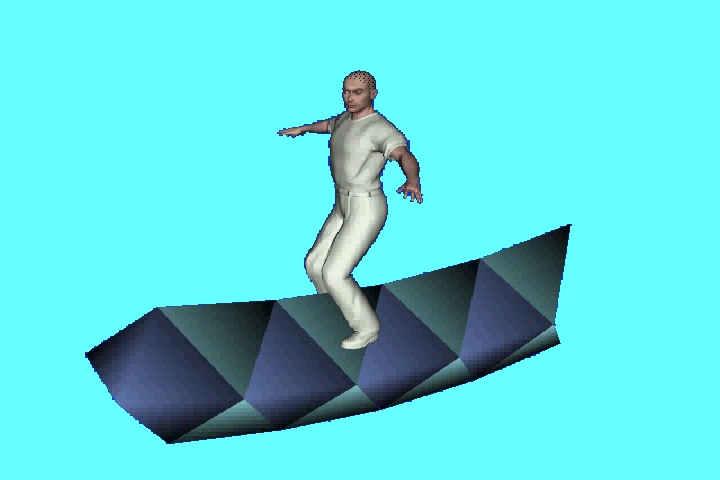 |
|
|
| Various materials, used in PXL manufacture, could be given a rating on a scale determined by how much a beam, made from a set number of units, sags under it's own weight. |
|
|
|
 |
|
|
|
TRIANGLE PXL FRAME |
|
|
|
Here, we have three PXL beams, combined to form a triangular frame. Using the assembly pictured, as a base, we could continue building a tetrahedron frame, which is thirteen times larger than a single PXL. The open space, in the center, could be left that way or covered with fabric. The center could also be filled in with more PXLs to form a solid wall, floor or ceiling.
|
|
|
|
OTHER TYPES OF PXL's |
|
|
The pneumatic crystal lattice principle works at any scale, using a large variety of materials. In attempts to produce prototypes, to demonstrate the principle, several different generations of models have been tested. Inflatable octahedrons and tetrahedrons, once built, are easy to assemble, but their manufacture had some drawbacks. The biggest challenge is getting all those edges aligned and sealed properly. Pre-formed polyhedra would be very useful, but probably the most expensive to make and sell. These were actually the second type of PXL that I built. The first and third generation turned out to be the forerunners of the most efficient and useful application of the principle.
Cloth PXL's
The first generation was used to test the balancing of forces at play, not whether a pxl would hold air. I made six inch equilateral triangle panels, cut from nylon fabric. I should say, the finished panels were 6", but the cut fabric was large enough to allow a half inch to be folded over, leaving a cleaner, stronger edge. Along each edge, I put equally spaced grommets. I used four, but have since come to prefer odd numbers of holes, since that always leaves one located at the center of the edge. That was all that had to be made. From there, assembly could begin. Triangles were then attached to each other, with string at each matching set of grommets, to form octahedrons and tetrahedrons. Wherever two hedrons are joined, only one panel was shared. In other words, to add a tetrahedron to any assembly, only three more panels are needed, instead of the four required for a full tetrahedron. The laced together panels now form a crystal lattice, but will hold air as well as a screen door in a submarine. This application of the technique uses a separate inner container to hold air, like an inner tube in a tire. I didn't have to make these. I used latex birthday party balloons, available at any grocery store. Between grommets there is enough space to spread the edges apart and insert an un-inflated balloon into the internal octahedron and tetrahedron cavities. I leave the opening of the balloon sticking out, until the balloon has been inflated and tied shut. When all of the cavities have been filled with inflated balloons, the resulting assembly becomes a strong, rigid structure. How strong? The first structure I built with these cloth panels and balloons far exceeded my expectations, built up over decades of theorizing. I challenged a friend, that weighed about two hundred pounds, to try popping the inclosed balloons by sitting on the assembly and bouncing up and down, as hard as he can. He huffed and he puffed and he bounced 'till he wore himself out, but he could not pop a single balloon. I showed this same assembly to my dad, an engineering genius, and the look of amazement and pride on his face has remained etched forever in my memory.
Two sided PXL'sWhen I discovered how time consuming it is to build complete octahedron and tetrahedron inflatable PXL prototypes, I looked for a more efficient method. In the store one day, I saw a heart shaped helium balloon. It occurred to me, that if it were made as a triangle, it would be the ideal PXL. You don't need to make two different styles (oct and tets). The triangle can be used to build them and many other shapes. They are much easier to manufacture, because there are no alignment issues. Stack two pieces of material and heat seal them together, with a heating element that is shaped like the seams. Ideally, this heating element would be heated by radio frequency, but with my limited budget I decided to build my first tooling using sheet metal and heating wire. The illustration below shows the heating element I made. The tabs, on the top side, were used to mount it to a piece of plywood, which was then attached, by hinges, to a plywood base. The finished tool works like a silk-screen printing set-up. |
|
|
|
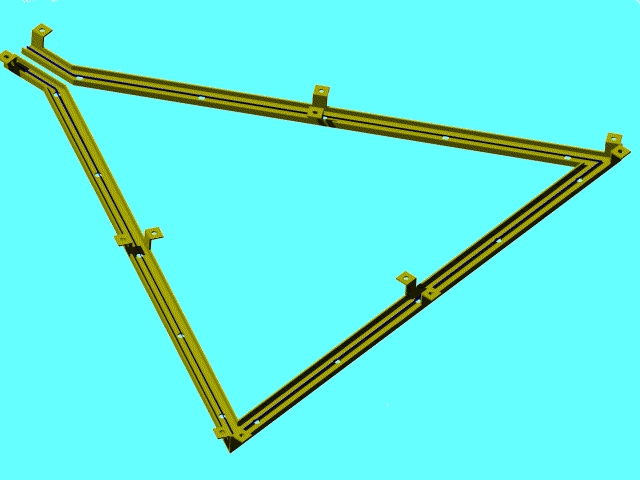 |
|
| Notice how the heating element incorporates an opening at one of the points of the triangle. This creates a stem for filling the balloon, eliminating any addition steps in the manufacturing process. Once the balloon is filled, the stem is rolled or folded and then held shut by a binder clip or tape. Below is a digital photo of one of the prototype PXL's that were made using this tooling. |
|
|
 |
|
|
| Here is an illustration, showing various sub-assembies. Clockwise, starting with the top, we have (1) an octahedron with 4 tetrahedrons, (2) an octahedron, (3) a tetrahedron, (4) half an octahedron, (5) a single PXL, (6) a hexagon, (7) a pentagram. Assemblies 4-7 would not be possible with PXL's made in only octahedron and tetrahedron shapes. Two sided PXL's are easier to make and also can be assembled in more ways than oct-tet types. |
|
|
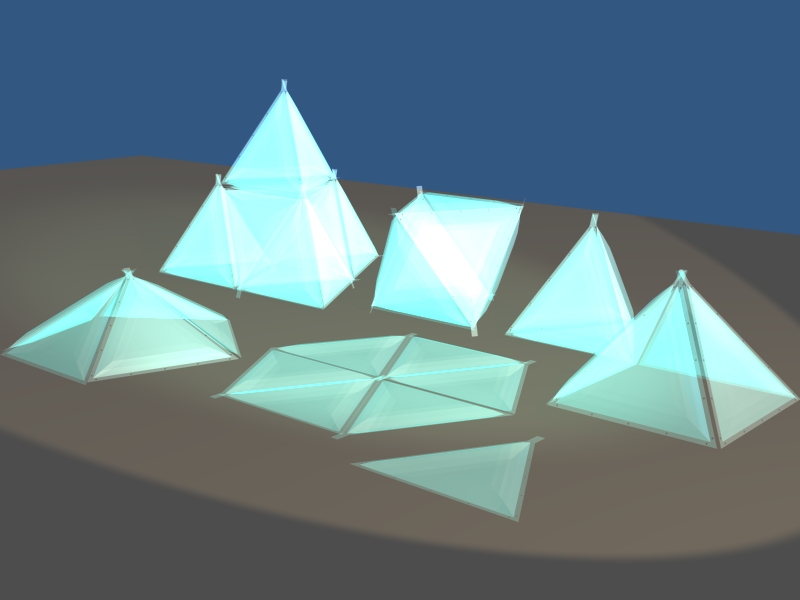 |
|
|
| Because, when not inflated, PXL balloons are flat, they can be silkscreened. Add the fact that they can be made from different colored materials and you can see the potential for large scale graphics. |
|
|
|
 |
|
|
|
Additional illustrations |
|
|
|
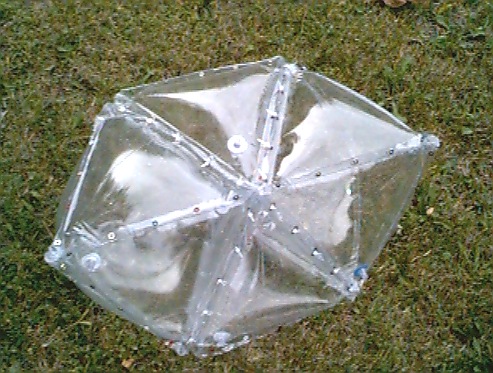 |
|
|
|
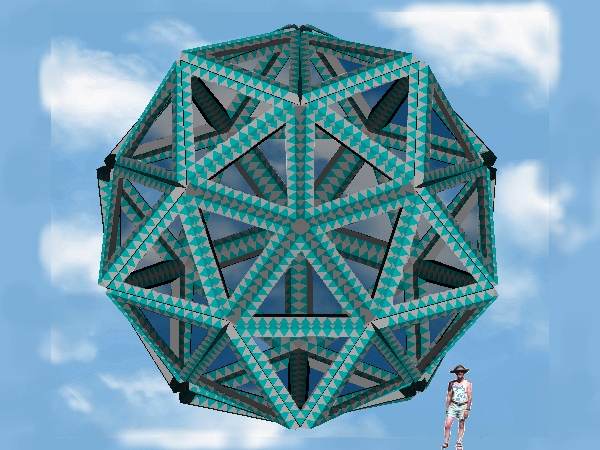 |
|
|
|
 |
|
|
|
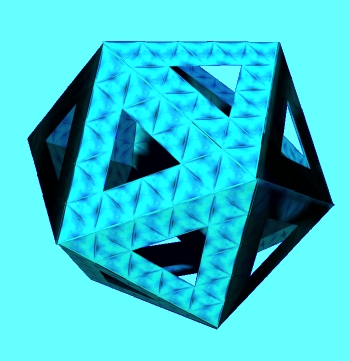 |
|
|
|
copyright2004, Rick Audette |
|
|
|

|
|















